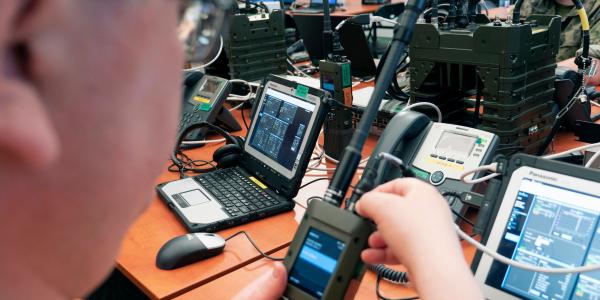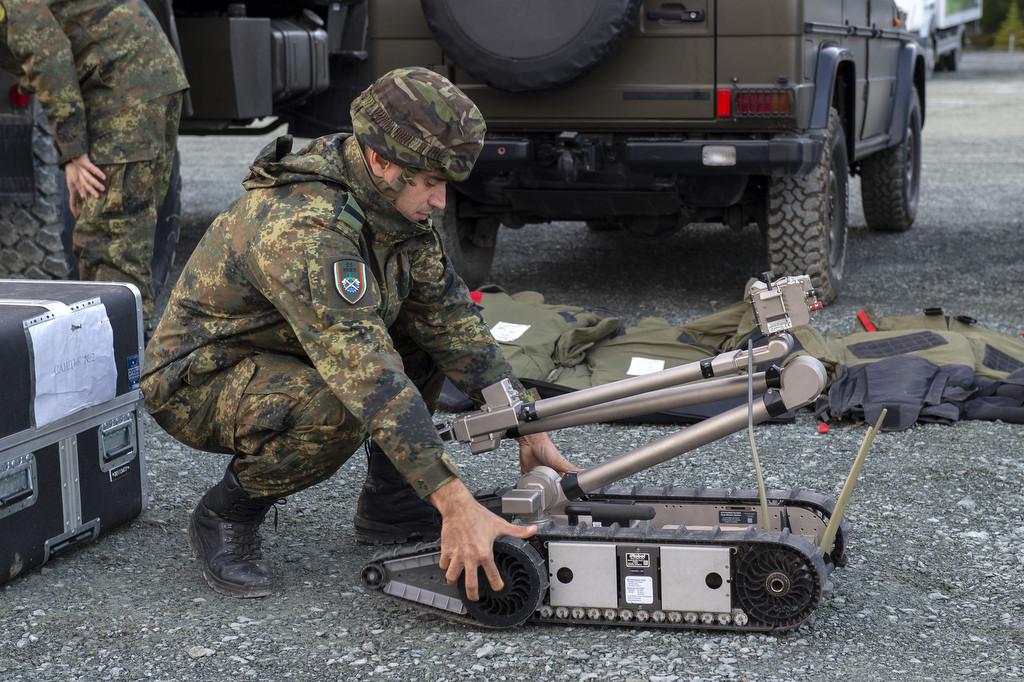Innovation Leads NATO Modernization Efforts
NATO is accelerating its efforts to input innovation into its operational capabilities. This effort is aided both by industry and academia and by different nations that bring new technology applications to the alliance table. But even the best ideas are encountering speed bumps, and adversaries are moving quickly to exploit their own technological advances.
Through its Allied Command Transformation (ACT), headquartered in Norfolk, Virginia, NATO has focused capability development on emerging technologies that can change battlespace operations. An innovation center developed with local academia is earmarked to grow into a full-fledged laboratory that would seed new capabilities into the force. And the ACT is improving NATO’s state-of-the-art battlefield network to accommodate advances in command and control (C2).
One advantage NATO has for innovation is strength in numbers. The alliance’s 29 members all have innovation assets that can be brought to bear in planning future military systems. Yet that broad membership also offers a significant drawback. The alliance must agree on systems that meet advanced capabilities and are interoperable among NATO’s members.
Lt. Gen. Thomas J. Sharpy, USAF, deputy chief of staff for capability development at the ACT, offers that the command is looking to the future to maintain a military edge across all the capabilities it delivers. This involves making sure it is applying innovation to either adapt current capabilities or revamp them, building on progress from science and technology advances in industry, academia and other nations.
“Hockey great Wayne Gretzky once said, ‘Good hockey players skate to where the puck is; great hockey players skate to where the puck is going to be,’” the general relates. “We are trying to figure out where the puck is going to be and develop those capabilities so that we maintain that military edge as our competitors are trying to do the exact same thing,” he declares.
The ACT has stood up an innovation branch within the capability development directorate to go with an innovation hub partnered with Old Dominion University. Gen. Sharpy notes that the directorate is moving ahead with plans to escalate this hub into a laboratory that would enable incremental as well as open innovation through academia. With the growth of this center, the ACT would align resources to extend innovation across all aspects of the ACT.
He describes this innovation center as “very effective at integrating with academia and like-minded personnel amongst the alliance.” It also is working with people who are not part of NATO to capture innovation as it emerges. He looks to improve this effort by providing the center with more resources and more people. This would enable it to be a laboratory where ideas could be cultivated with industry for demonstrations by the military. Another advantage would be that the facility is located in the United States, so U.S. participants would not have to travel to and across Europe to deal with NATO.
The ACT has developed an emerging disruptive technology road map that focuses on command and control, big data, artificial intelligence (AI), automation, hypersonics and other areas that many nations also are exploring. This effort is part of the command’s overall thrust. “We’re not only trying to put coherence into those systems that we have, but also are trying to look at using innovation to make them maintain cutting edge so we maintain our military edge going forward,” Gen. Sharpy says. “We don’t want to be lagging in those, because those are the big rocks that we are trying to move.
“Even though we might not be in a conflict, I would say that cyber is a contested domain every single day,” the general continues. “Being able to leverage the same opportunities that cyber provides us from a good standpoint also enables our adversaries in the negative standpoint, because they have the same capabilities.”
As with many Western militaries, the emergence of global near-peer competitors has caused the biggest course change in the ACT, Gen. Sharpy offers. The nature of the NATO alliance has provided an opportunity for other nations to figure out how they can thwart the strength of the alliance, he points out. This is evident in the hybrid activities seen recently, along with the expansion of regional conflicts into global effects. He cites China as an example: “What happens in China impacts Europe, and what happens in Europe impacts China. And what happens in Europe certainly impacts what happens in North America, South America and especially Russia.
“The world is connected in ways it hasn’t been in the past … and so near-peer competitors are operating at a speed different than when NATO was founded,” he continues. “Back in the day, militaries used to drive innovation and technology, but in today’s world, industry is doing a much better job in some of those fields than we are. Our adversaries have those same opportunities, and so our challenge is to figure out how we maintain that deterrent effect that gives us the edge. Doing so in a contested and connected world is a lot harder than it’s ever been,” the general concedes.
He adds that NATO’s concerns go beyond the main near-peer competitors. Issues such as terrorism, mass migration and resources have increased the number of challenges the alliance must face. “There are a lot more players in the world today than there were even back in the World War II era,” he states.
But near-peer competition is the topic of major efforts today. The general relates that NATO’s Trident Juncture 2018 exercise featured nearly two dozen different experiments, one of which was an information environment assessment. AI and autonomous systems helped participants survey the battlefield using the Internet and other systems to predict where and how an adversary would react to certain actions. With these results, the commander would be able to make decisions based on how his or her actions would be perceived.
Leveraging that technology across all domains is a major challenge facing the ACT, the general continues. These capabilities must be updated and innovative processes must be applied, and the entire suite must be interoperable.
“Being able to communicate and command and control all those lethal fires in a timely manner has really made it more dynamic and more challenging,” he says.
“If we develop a capability by a single nation or group of nations, and then we try to use it for the alliance, it has to be interoperable,” he emphasizes. “We have to make sure that, if it is a communications or a C2 capability, it can be used by all the member nations and not just a single nation. If it’s not interoperable, then it’s not very useful when it comes to the alliance,” he adds.
And the ACT will be depending on both internal and commercial technologies, the general says. He notes that industry is leading in many of the areas in which the ACT is working, such as cyber and C2, and the ACT seeks to adapt these technologies and capabilities for alliance military use.
One of the most important focal points is Federated Mission Networking, or FMN. With all its planned spirals, the interoperable system will constantly evolve. “It’s continually going to be in upgrade mode,” Gen. Sharpy states. One of its key elements is that it will teach and enable interoperability whether in training or an operational environment.
The general allows that he would like to see more people fully buy into FMN as a hosted entity. If more people use, train in and exercise in it, that will help NATO interoperate more effectively. And this touches upon more than technical issues.
“One of our challenges is, How do we share data? We share our nations’ treasures in our airmen, soldiers and sailors in combat together, but it seems to me we have a problem sharing data,” he states. “FMN gives us the ability to build the trust so that we can then hopefully get to where data sharing is not as much of a challenge as it currently seems to be.”
For FMN to continue to grow, it needs consistent funding, the general offers. FMN must be assured of having both Spiral 3 and Spiral 4—one to complete work underway, the other to continue development. “We have to continue to invest to provide the infrastructure that is necessary to be successful in the dynamic cyber threat in the world that we live, and I believe FMN is key to us having that on behalf of the alliance,” he declares.
“It’s good today, but as the adversary adapts … we’re going to continue to have to spiral and upgrade FMN to be relevant into the future.”
Even with the advantages brought to the battlespace by FMN, the system is not a panacea for everything challenging NATO. The introduction of multidomain operations will require more than just the existing FMN to serve the alliance. “Operating in the single domain with its speed and lethality is challenging enough,” the general says. “It’s hard to do single domain well, especially when it’s just a single service within a single nation. Complicate that by multiplying it by 29, it becomes even harder … and then when you try to do multidomain, it makes it even harder.
“FMN can provide us some capabilities in that area, but unfortunately we have to have an architecture that enables those single domains to be fed into a multidomain,” he explains. “It’s really a system-of-system type approach; you have to have an architecture that is hard to design and hard to build.” Most nations are struggling with it, including the United States, he adds. “How do we take a single domain from air C2, land C2, sea C2, space C2, cyber C2 and then bring them into a single all-domain concept in an architecture that actually allows all 29 [alliance members] to use it for their national purposes and on behalf of the alliance—and maintain that interoperability?” The ACT is working with its partners and looking to draw from other nations’ efforts to overcome what the general calls “this very difficult challenge.”
To bring new capabilities to the force, a top priority for the ACT is the new common funded capability delivery model. Gen. Sharpy describes it as a new model that takes a disciplined approach to delivering common funded capabilities for the alliance. It incorporates best practices from industry and other nations for moving a capability from requirement through tools—doctrinal, organizational, informational—to deliver it interoperably into the hands of the warfighter before it is needed.
Consequently, the ACT is broadening its reach, Gen. Sharpy offers. The command is proceeding in a more deliberate manner to provide NATO nations with the information they need for decision making.
Another ACT priority is NATO Command Structure (NCS) adaptation. This follows up on decisions made by alliance leadership last summer, and the ACT is reorganizing along the lines of the new NCS capabilities and personnel. Gen. Sharpy relates that most military organizations trade out roughly one-third of their personnel each year, but his directorate has added 40 more people this year, and these changes must be achieved concurrently and quickly. This effort is complicated by NATO’s structure of 29 nations with different cultures, he notes.






Comments